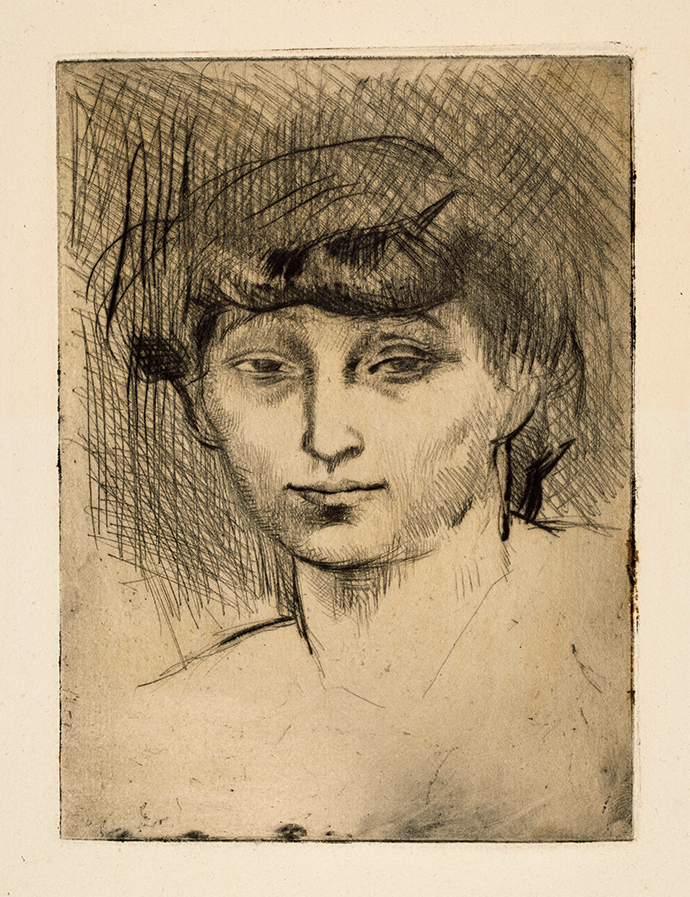Beautiful Fernande at the Musée de Montmartre
As part of the celebration of the fiftieth anniversary of Picasso's death, the Musée de Montmartre is organizing an exhibition about the artist and his relationship with Fernande Olivier, a central figure in the Montmartre avant-garde who shared her life with Picasso at the Bateau-Lavoir.
Fernande Olivier, who became the artist's companion soon after he moved to Paris in 1903, remains scarcely known. The beginning of their relationship overlapped with the end of the Blue Period and the artist’s ventures into new experiments, such as Cubism, in the enchanting setting of what Max Jacob named the "Bateau-Lavoir" (the washhouse boat). This uncomfortable wooden house in Montmartre sheltered penniless artists who rubbed shoulders with a motley crew of humble people. Meeting this beautiful muse appears to have been important for the painter's balance at a time when he was in a state of artistic and personal turmoil.
Fernande Olivier, whose real name was Amélie Lang, changed her identity around 1900 in unclear circumstances, four years before she met Picasso. Fernande-Amélie, who was brought up by her aunt and uncle from a very young age, was not a happy child. Her aunt terrified her and cut her off from the tenderness she received from her uncle, who was too weak to assert himself. Fernande was intelligent and a good student; she liked learning, writing, and reading ("It annoys me just to dabble in things I'm really excited by, and I want to go into them more deeply. So I spend most my time reading, as that allows me to study more seriously").[1]
She was too young when she fled from the grips of a stifling family to marry a violent man who made her unhappy. At a desperate moment, she found refuge with a young sculptor, Laurent Debienne; he took her in and she became his mistress. He introduced her to the bohemian life, and she moved to the Bateau-Lavoir with him. The penniless couple lived mainly off the money that Fernande earned sitting for artists, and she rapidly became one of the favorite models around. She kept a journal for years, and in her memoir she recalls sitting for Henner, Ricard Canals, Carolus-Duran, Boldini, and Friesz, among others. The lack of love during her childhood plunged Fernande into a permanently unsatisfied pursuit of embraces and caresses. Every lover disappointed her; her life did not fulfil her; her anxieties never ceased. It was in this difficult personal situation that she met Picasso, whom she had already seen briefly ("there is a Spanish painter in the house […] who looks at me with large, heavy eyes, both penetrating and reflective, full of a contained fire and so intensely that I cannot help looking at him too.")[2] In 1904, an on-and-off relationship began ("I've been back to see my Spanish painter. He adores me with real sincerity, which I find moving." [3])
Soon thereafter, Fernande moved in with Picasso, into the studio she described in her book Picasso and His Friends: “There was a mattress on four legs in one corner. A little iron stove, covered in rust with an earthenware bowl on it, served for washing; a towel and a minute cake of soap lay on a white wood table beside it. […] easels, canvases of every size and tubes of paint were scattered all over the floor, brushes [...]."[4] Even long after their separation, the studio of the Rose Period remained full of happy memories for both of them. During those wonderful years, Fernande stopped working as a model, following Picasso's request: he was jealous and could not bear to see his companion sit for others. Fernande would also have liked to paint ("I had been trying to paint for a long time, I was gifted; I would have liked to be directed, to receive Pablo's advice but he refused: 'What you do is more interesting than what you would do following someone else's advice.'")[5]
As time went by, their relationship became increasingly tense and finally ended in 1912. She kept a certain nostalgia ("only one person ever loved me, and I ended up loving him with all my heart, although that did not prevent me later, as I was often cruel to him, to leave him brutally and tear myself away the day I noticed he had begun to love me less.")[6]
The following years were difficult for Fernande; she recited poetry at the Lapin Agile and then took on small jobs, even becoming a horoscope reader. Later on, she shared her life with Roger Karl, a French tragic actor and Sarah Bernhardt's partner, but ended up growing old alone (Picasso, alerted to her situation by Mrs. Braque, came to her aid in the late 1950s). Nevertheless, she managed to keep some certain joie de vivre, in complete disarray yet with complete serenity. Fernande Olivier died on January 29, 1966. She wrote two books that offer us moving details about Picasso's work and the bohemian, artistic, and intellectual scene preceding the First World War.
The exhibition Fernande Olivier et Pablo Picasso, dans l’intimité du Bateau-Lavoir is on view at the Musée de Montmartre from October 14, 2022 to February 19, 2023 as part of the Picasso Celebration 1973-2023.





 Summary
Summary